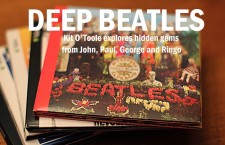Take one part R&B, one part Buddy Holly and another part Everly Brothers and the result is “Thank You Girl,” the B-side to the 1963 single “From Me to You.” Ringo Starr’s pounding drumming, John Lennon’s bluesy harmonica, and Lennon and Paul McCartney’s tight harmonies make for an unfairly unappreciated early track.
Originally intended as an A-side, “Thank You Girl” was eventually replaced with “From Me to You.” Drawing from past interviews, Anthology quoted Lennon’s summary of the song’s fate: “We’d already written ‘Thank You Girl’ as the follow-up to ‘Please Please Me.’ This new number [‘From Me To You’] was to be the b-side. We were so pleased with it, we knew we just had to make it the a-side, Thank You Girl the b.” As Lennon stated in one of his last interviews, “‘Thank You Girl’ was one of our efforts at writing a single that didn’t work.”
According to the Beatles Bible, the song was a true collaboration between Lennon and McCartney, with the former writing the verses while the latter contributed the chorus and middle eight. Paul McCarney claimed the inspiration for “Thank You Girl” was the fans themselves: “We knew that if we wrote a song called ‘Thank You Girl’ that a lot of the girls who wrote us fan letters would take it as a genuine thank you. So a lot of our songs were directly addressed to the fans,” he said in 1988.
Originally titled “Thank You, Little Girl,” the song was recorded over March 5 and 13, 1963. John Lennon assumed lead vocals, rhythm guitar, and harmonica; McCartney played bass and sang harmony vocals; George Harrison took over on lead guitar; and Ringo Starr played, of course, the drums. With the usual team of George Martin and engineer Norman Smith presiding, the Beatles recorded the track in six takes; they also taped seven more edit pieces. The final version is an edit of takes six and 13. Lennon returned to Abbey Road on March 13 to overdub his harmonica part, which took 15 attempts.
Martin then completed an intricate edit of takes six and 13 along with Lennon harmonica takes 17, 20, 21, and 23, according to the Beatles Bible. Martin and Smith then finished the session by creating the mono and stereo mixes. As is typical for these mixes, the mono and stereo singles slightly vary. The Beatles Recording Variations site states that the stereo mix features additional harmonica edit pieces in the middle and at the end as well as more echo.
Despite its B-side status, “Thank You Girl” did receive media exposure. The Beatles performed it during their first national television appearance on the BBC’s The 625 Show on Saturday, April 13; they subsequently played the song on radio shows Side by Side, Steppin’ Out, and Easy Beat (this version appears on the Live at the BBC compilation).
“Thank You Girl” stands as a notable track for revealing the Beatles’ many early influences. Lennon and McCartney’s close harmonies recall those by the Everly Brothers, such as in the duo’s classic “Wake Up Little Susie.” Even more obvious are the “ohs,” which pay homage to their idol Buddy Holly. Holly revolutionized rock vocalization with his hiccups, nasal sound, and trademark “ohs” in cuts such as “Peggy Sue” and “Everyday”; Lennon and McCartney imitate the sound before Lennon sings the first and second verses.
Another possible influence is the Tommy Roe single “Sheila,” the 1962 hit that more than echoes “Peggy Sue.” Note that the “ohs” sound very similar to Lennon and McCartney’s rendition.
No matter the inspiration, “Thank You Girl” succeeds based on Ringo Starr’s furious drumming (particularly during the harmonica sections and toward the end) as well as John Lennon’s blues-inflected harp playing. Finally, Lennon and Paul McCartney’s vocals emphasize the song’s “hook,” the lines “And all I gotta do / Is thank you girl, thank you girl.”
The lyrics reflect the songwriters’ early tendency to directly address the listener, beginning with the first line “You’ve been good to me, you made me glad when I was blue.” The narrator wants to proclaim their love to the world and puts down those who would doubt their true intentions. When the two singers perfectly harmonize on the verse, “and eternally I’ll always be in love with you,” one can easily imagine their female fans swooning.
This technique also demonstrates the Beatles’ trademark close vocals and ability to write and perform a memorable musical phrase. Those impressive harmonies ensure that their words — and the song itself — will linger in the memory.
While “Thank You Girl” may have missed its chance to become an A-side, it serves as an important reminder that blues, R&B, and early rock ’n’ roll are vital ingredients to the Beatles’ early sound. They provided the foundations on which they built “Love Me Do,” “From Me to You,” and lesser-known songs like “Little Child.” The song’s chugging, driving guitars, the harmonica, and Starr’s forceful drumming style lend the song edge, yet its romantic lyrics and Lennon and McCartney’s ebullient vocals place “Thank You Girl” firmly in the pop realm.
- The Rescued Early Paul McCartney Song That Completed ‘Beatles For Sale’ - December 4, 2024
- A Rare Beatles Cover Proves John Lennon Was Wrong About His Voice - November 26, 2024
- How John Lennon Came Roaring Back on the Beatles’ White Album - November 22, 2023


